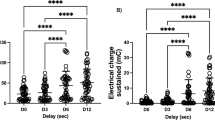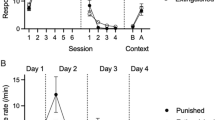Abstract
In two experiments, rats were shocked every 30 sec. Before a response, a bar press, shocks were long (2 sec); for 3 min after a response, shocks were short (0.1, 0.5, or 1 sec). When responding reduced shocks from 2 to 0.1 sec, bar pressing was acquired, and the shorter the shocks the more time spent with the short-shock condition in effect. In another procedure, the duration of individual shocks following a response was controlled so that the first shock was as long as those before the response (2 sec), but the remaining shocks in the 3-min period were short (0.1 sec). Bar pressing was maintained in some rats and acquired in others showing that, even when delayed, a reduction in shock duration is reinforcing. The latter findings question the generality of a two-factor, safety-signal interpretation of negative reinforcement. These results plus others imply that to predict responding in aversive situations it is necessary to integrate, for at least several minutes, the parameters of aversive events that follow a response.
Similar content being viewed by others
References
ANGER, D. 1963. The role of temporal discrimination in the reinforcement of Sidman avoidance behavior. Journal of the Experimental Analysis of Behavior, 6, 477–506.
AZRIN, N. H., ULRICH, R. E., HUTCHINSON, R. R., & NORMAN, D. G. 1964. Effect of shock duration on shock-induced fighting. Journal of the Experimental Analysis of Behavior, 7, 0–11.
BADIA, P., & CULBERTSON, S. 1972. The relative aversiveness of signalled vs. unsignalled escapable and inescapable shock. Journal of the Experimental Analysis of Behavior, 17, 463–471.
BADIA, P., CULBERTSON, S., & LEWIS, P. 1971. The relative aversiveness of signalled vs. unsignalled avoidance. Journal of the Experimental Analysis of Behavior, 16, 113–121.
BAUM, W. M. 1973. The correlation-based law of effect. Journal of the Experimental Analysis of Behavior, 20, 137–153.
BERSH, P. J., & ALLOY, L. B. 1978. Avoidance based on shock intensity reduction with no change in shock probability. Journal of the Experimental Analysis of Behavior, 30, 293–300
BITTERMAN, M. E., REED, P., & KRANSKOPF, S. 1952. The effect of duration of the unconditioned stimulus upon conditioning and extinction. American Journal of Psychology, 65, 256–262.
BOLLES, R. C. 1970. Species-specific defense reactions and avoidance learning. Psychological Review, 77, 32–48.
DINSMOOR, J. A. 1977. Escape, avoidance, and punishment: Where do we stand? Journal of the Experimental Analysis of Behavior, 28, 83–95.
FISHER, C., & BADIA, P. 1975. Preference for signalled or unsignalled shock in goldfish. 1976, Psychonomic Bulletin, 2, 195–197.
GARDNER, E. T., & LEWIS, P. 1976. Negative reinforcement with shock-frequency increase. Journal of the Experimental Analysis of Behavior, 25, 3–14.
GARDNER, E. T., & LEWIS, P. 1977. Parameters affecting the maintenance of negatively reinforced key pecking. Journal of the Experimental Analysis of Behavior, 28, 117–131.
GRIFFIN, P., HONAKER, L. M., JONES, D. E., & PHNES, L. T. 1974. Preference for signalled vs. unsignalled shock in pigeons with implanted electrodes. Bulletin of the Psychonomic Society, 4, 114–143.
HARSH, S., & BADIA, P. 1974. Concurrent assessment of the positive and negative properties of a signalled shock schedule. Animal Learning and Behavior, 2,168–172.
HERRNSTEIN, R. J. 1970. On the Law of Effect. Journal of the Experimental Analysis of Behavior, 13, 243–266.
HERRNSTEIN, R. J., & HINELINE, P. N. 1966. Negative reinforcement as shock-frequency reduction. Journal of the Experimental Analysis of Behavior, 9, 421–430.
HINELINE, P. N. 1970. Negative reinforcement without shock reduction. Journal of the Experimental Analysis of Behavior, 14, 259–268.
LAMBERT, J. V., BERSH, P. J., HINELINE, P. N. & SMITH, G. D. 1973. Avoidance conditioning with shock contingent upon the avoidance response. Journal of the Experimental Analysis of Behavior, 19, 361–367.
LEWIS, P., & GARDNER, E. T. 1977. The reliability of preference for signalled shock. Bulletin of the Psychonomic Society, 9, 135–138.
LEWIS, P., GARDNER, E. T., & HUTTON, L. V. 1976. Integrated delays to shock as negative reinforcement. Journal of the Experimental Analysis of Behavior, 26, 379–386.
MOWRER, O. H., & SOLOMON, L. M. 1954. Continguity vs. drive-reduction in conditioned fear; the proximity and abruptness of drive-reduction. American Journal of Psychology, 67, 15–25.
OVERMIER, J. B. 1966. Instrumental and cardiac indices of Pavlovian conditioning as a function of Us duration. Journal of Comparative and Physiological Psychology, 62, 15–20.
POWELL, R. W., & PECK, S. 1969. Persistent shock-elicited responding engendered by a negative-reinforcement procedure. Journal of the Experimental Analysis of Behavior, 12, 1049–1062.
RESCORLA, R. A., & SOLOMON, R. L. 1967. Two-process learning theory: Relationships between Pavlovian conditioning and instrumental learning. Psychological Review, 74, 151–182.
RUNQUIST, W. N., & SPENCE, K. W. 1959. Performance in eyelid conditioning related to changes in muscular tension and physiological measures of emotionality. Journal of Experimental Psychology, 58, 417–422.
SCHOENFELD, W. N. 1950. An experimental approach to anxiety, escape, and avoidance behavior. In P. H. Hock & J. Jubin (Eds.), Anxiety. New York: Grune & Stratton.
WEGNER, N., & ZEAMAN, D. 1958. Strength of cardiac Cr’s with varying unconditioned stimulus durations. Psychological Review, 65, 238–241.
Author information
Authors and Affiliations
Additional information
This research was supported in part by NIMH Grant No. 1R01 MH9593-2 to Ohio University and by grant OURC 521 from the Ohio University Research Committee. We thank Robin Eichenbaum, Bev Reid, and Jean Reis for help in collecting the data, and George Cohen, Martin McKibben, and Jeff Coulter for graphics and photographic assistance.
Rights and permissions
About this article
Cite this article
Lewis, P., Gardner, E.T. & Lopatto, D. Shock-Duration Reduction as Negative Reinforcement. Psychol Rec 30, 219–228 (1980). https://doi.org/10.1007/BF03394672
Published:
Issue Date:
DOI: https://doi.org/10.1007/BF03394672




